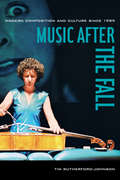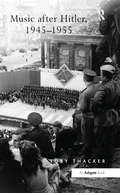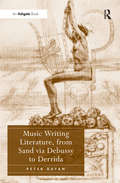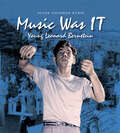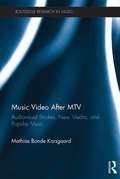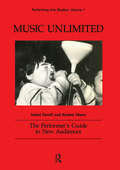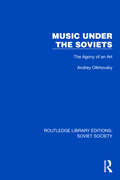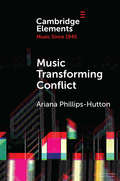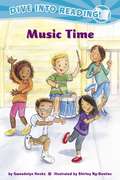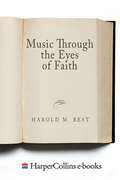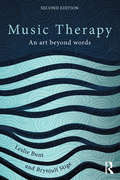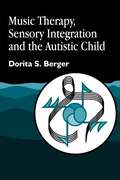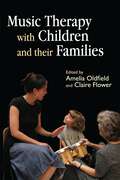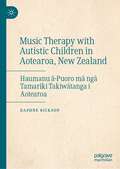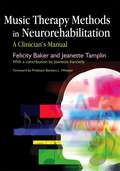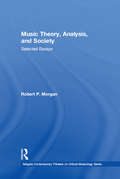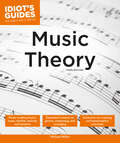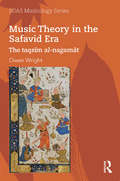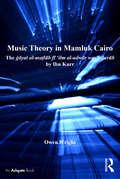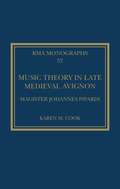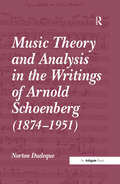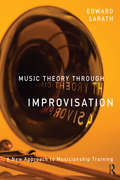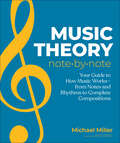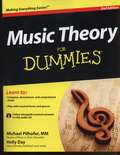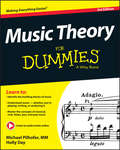- Table View
- List View
Music after the Fall: Modern Composition and Culture since 1989
by Tim Rutherford-JohnsonMusic after the Fall is the first book to survey contemporary Western art music within the transformed political, cultural, and technological environment of the post–Cold War era. In this book, Tim Rutherford-Johnson considers musical composition against this changed backdrop, placing it in the context of globalization, digitization, and new media. Drawing connections with the other arts, in particular visual art and architecture, he expands the definition of Western art music to include forms of composition, experimental music, sound art, and crossover work from across the spectrum, inside and beyond the concert hall. Each chapter is a critical consideration of a wide range of composers, performers, works, and institutions, and develops a broad and rich picture of the new music ecosystem, from North American string quartets to Lebanese improvisers, from electroacoustic music studios in South America to ruined pianos in the Australian outback. Rutherford-Johnson puts forth a new approach to the study of contemporary music that relies less on taxonomies of style and technique than on the comparison of different responses to common themes of permission, fluidity, excess, and loss.
Music after Hitler, 1945-1955
by Toby ThackerThe political control of music in the Third Reich has been analysed from several perspectives, and with ever increasing sophistication. However, music in Germany after 1945 has not received anything like the same treatment. Rather, there is an assumption that two separate musical cultures emerged in East and West alongside the division of Germany into two states with differing economic and political systems. There is a widely accepted view of music in West Germany as 'free', and in the East subject to party control. Toby Thacker challenges these assumptions, asking how and why music was controlled in Germany under Allied Occupation from 1945-1949, and in the early years of 'semi-sovereignty' between 1949 and 1955. The 're-education' of Germany after the Hitler years was a unique historical experiment and the place of music within this is explored here for the first time. While emphasizing political, economic and broader social structures that influenced the production and reception of different musical forms, the book is informed by a sense of human agency, and explores the role of salient individuals in the reconstruction of music in post-war Germany. The focus is not restricted to any one kind of music, but concentrates on those aspects of music, professional and amateur, live and recorded, which appeared to be the mostly highly charged politically to contemporaries. Particular attention is given to 'denazification' and to the introduction of international music. Thacker traces the development of a divide between Communist and liberal-democratic understandings of the place of music in society. The contested celebrations of the Bach Year in 1950 are used to highlight the role of music in the broader cultural confrontation between East and West. Thacker examines the ways in which central governments in East and West Germany sought to control and influence music through mechanisms of censorship and positive support. The book will therefore be of interest not only
Music Writing Literature, from Sand via Debussy to Derrida
by Peter DayanWhy does poetry appeal to music? Can music be said to communicate, as language does? What, between music and poetry, is it possible to translate? These fundamental questions have remained obstinately difficult, despite the recent burgeoning of word and music studies. Peter Dayan contends that the reasons for this difficulty were worked out with extraordinary rigour and consistency in a French literary tradition, echoed by composers such as Berlioz and Debussy, which stretches from Sand to Derrida. Their writing shows how it is both necessary and futile to look for music in poetry, or for poetry in music: necessary, because each art defines itself by reference to what it is not, and cannot be, in order to point to an idealized totality outside itself; futile, because the musicality of poetry, like the poetic meaning of music, must remain as elusive as that idealized totality; its distance is the very condition of the art. Thus is generated a subtle but unmistakable general definition of the nature of art which has proved uniquely able to survive all the probings of poststructuralism. That definition of art is inseparable from a disturbingly effective scepticism towards all forms of explication and explanation in critical discourse, so it is doubtless not surprising that critics in general have done their best to ignore it. But by bringing out what Sand, Baudelaire, Mallarmé, Proust, Debussy, Berlioz, Barthes, and Derrida all do in the same way as they work on the limits of the analogy between music and literature, this book shows how it is possible, productive, illuminating, and fascinating to work on those limits; though to do so, as we find repeatedly, in Chopin's dreams as in Derrida's 'tombeaux', requires us to have the courage to face, in music, our literal death, and the limits of our intelligence.
Music Was IT: Young Leonard Bernstein
by Susan Goldman Rubin"Life without music is unthinkable."—Leonard Bernstein, FindingsWhen Lenny was two years old, his mother found that the only way to soothe her crying son was to turn on the Victrola. When his aunt passed on her piano to Lenny’s parents, the boy demanded lessons. When Lenny went to school, he had the most fun during "singing hours."But Lenny’s love of music was met with opposition from the start. Lenny’s father, a successful businessman, wanted Lenny to follow in his footsteps. Additionally, the classical music world of the 1930s and 1940s was dominated by Europeans—no American Jewish kid had a serious chance to make a name for himself in this field.Beginning with Lenny’s childhood in Boston and ending with his triumphant conducting debut at Carnegie Hall with the New York Philharmonic when he was just twenty-five, MUSIC WAS IT draws readers into the energetic, passionate, challenging, music-filled life of young Leonard Bernstein.Archival photographs, mostly from the Leonard Bernstein Collection at the Library of Congress, illustrate this fascinating biography, which also includes a foreword by Bernstein’s daughter Jamie. Extensive back matter includes biographies of important people in Bernstein’s life, as well as a discography of his music.
Music Video After MTV: Audiovisual Studies, New Media, and Popular Music (Routledge Research in Music)
by Mathias Bonde KorsgaardSince the 1980s, music videos have been everywhere, and today almost all of the most-viewed clips on YouTube are music videos. However, in academia, music videos do not currently share this popularity. Music Video After MTV gives music video its due academic credit by exploring the changing landscapes surrounding post-millennial music video. Across seven chapters, the book addresses core issues relating to the study of music videos, including the history, analysis, and audiovisual aesthetics of music videos. Moreover, the book is the first of its kind to truly address the recent changes following the digitization of music video, including its changing cycles of production, distribution and reception, the influence of music videos on other media, and the rise of new types of online music video. Approaching music videos from a composite theoretical framework, Music Video After MTV brings music video research up to speed in several areas: it offers the first account of the research history of music videos, the first truly audiovisual approach to music video studies and it presents numerous inspiring case studies, ranging from classics by Michel Gondry and Chris Cunningham to recent experimental and interactive videos that interrogate the very limits of music video.
Music Unlimited: The Performer's Guide to New Audiences (Performing Arts Studies #Vol. 1)
by Isabel Farrell Kenton MannThis book is designed to be a music performer's companion, informing the performer's decisions as they prepare performances. It describes some of the situations in which performers will find themselves and also the techniques which work for performers while performing in community venues.
Music Under the Soviets: The Agony of an Art (Routledge Library Editions: Soviet Society)
by Andrey OlkhovskyMusic Under the Soviets (1955) examines the concept of Soviet music, its special characteristics and its differences from the musical tradition of the West. As the musical practice under the Soviet totalitarian dictatorship, it should be viewed as the musical policy of that regime, a policy which aims at the ‘reconstruction’ of not only the historically developed musical forms but the essence of music itself as artistic creation. It was during the years of Stalin that Soviet music acquired its peculiar features, developed its most characteristic distinguishing marks, and determined the paths of its evolution.
Music Transforming Conflict (Elements in Music since 1945)
by Ariana Phillips-HuttonTeach the world to sing, and all will be in perfect harmony - or so the songs tell us. Music is widely believed to unify and bring peace, but the focus on music as a vehicle for fostering empathy and reconciliation between opposing groups threatens to overly simplify our narratives of how interpersonal conflict might be transformed. This Element offers a critique of empathy's ethical imperative of radical openness and positions the acknowledgement of moral responsibility as a fundamental component of music's capacity to transform conflict. Through case studies of music and conflict transformation in Australia and Canada, Music Transforming Conflict assesses the complementary roles of musically mediated empathy and guilt in post-conflict societies and argues that a consideration of musical and moral implication as part of studies on music and conflict offers a powerful tool for understanding music's potential to contribute to societal change.
Music Time
by Gwendolyn Hooks Shirley Ng-BenitezHenry dreams of becoming a rock star drummer and practices at home whenever he can. One day while Henry is drumming, his mom has to work, and asks him to stop playing. Henry decides to go outside to play his drum and he sees his friends. Henry wants to keep practicing, but he also wants to play with his friends. By playing Freeze Dance, he can do both. And when his mother finishes work that evening, they figure out how to enjoy music together too.
Music Through the Eyes of Faith
by Harold Best"Christian musicians know of the obligation to make music as agents of God's grace. They make music graciously, whatever its kind or style, as ambassadors of Christ, showing love, humility, servanthood, meekness, victory, and good example . . . Music is freely made, by faith, as an act of worship, in direct response to the overflowing grace of God in Christ Jesus."Co-sponsored by the Christian College Coalition, this thought-provoking study of music-as-worship leads both students and experienced musicians to a better understanding of the connections between music making and Christian faith."Christian music makers have to risk new ways of praising God. Their faith must convince them that however strange a new offering may be, it cannot out-reach, out-imagine, or overwhelm God. God remains God, ready to swoop down in the most wonderful way, amidst all of the flurry and mystery of newness and repetition, to touch souls and hearts, all because faith has been exercised and Christ's ways have been imitated. Meanwhile, a thousand tongues will never be enough."Best relates musical practice to a larger theology of creation and creativity, and explores new concepts of musical quality and excellence, musical unity, and the incorporation of music from other cultures into today's music.
Music Therapy: An art beyond words (Ashgate Popular And Folk Music Ser.)
by Leslie Bunt Brynjulf StigeMusic therapy is recognised as being applicable to a wide range of healthcare and social contexts. Since the first edition of Music Therapy: An art beyond words, it has extended into areas of general medicine, mainstream education and community practice. This new edition revises the historical and theoretical perspectives and recognises the growing evidence and research base in contemporary music therapy. Leslie Bunt and Brynjulf Stige document the historical evolution of music therapy and place the practice within seven current perspectives: medical, behavioural, psychoanalytical, humanistic, transpersonal, culture-centred and music-centred. No single perspective, individual or group approach is privileged, although the focus on the use of sounds and music within therapeutic relationships remains central. Four chapters relate to areas of contemporary practice across different stages of the lifespan: child health, adolescent health, adult health and older adult health. All include case narratives and detailed examples underpinned by selected theoretical and research perspectives. The final two chapters of the book reflect on the evolution of the profession as a community resource and the emergence of music therapy as an academic discipline in its own right. A concise introduction to the current practice of music therapy around the world, Music Therapy: An art beyond words is an invaluable resource for professionals in music therapy and music education, those working in the psychological therapies, social work and other caring professions, and students at all levels.
Music Therapy, Sensory Integration and the Autistic Child
by Dorita S. BergerMusic's ability to influence emotions and moods is universally acknowledged, and music therapists have long known that stimulating the brain through the auditory system is a key to obtaining remarkable responses. Music therapy is a particularly effective tool when working with children with autism spectrum conditions, because music communicates with these children on a level where mere words cannot go. Written in a way that is both informative for the professional and accessible for parents, this book furthers the already strong case for the use of music therapy as a resource to encourage behavioural changes for the better in children with autism spectrum conditions. Placing particular emphasis upon sensory integration, the author discusses contributing factors to the behaviour of people on the autism spectrum, and, through the use of case studies, presents the latest approaches in music therapy that are enabling children with autism spectrum conditions to better cope with sensory integration.
Music Therapy with Children and their Families
by Amelia Oldfield Colette Salkeld Emma Davies Jassenka Horvat Claire Flower Helen Loth Sarah Russel Kay Sobey Joy Hasler Nicky O'Neill Rachel Bull Vince Hesketh Tiffany HughesIn the past, music therapy work with children typically took place in special schools without the family being present. More recently, music therapy has become a widespread practice, and this book reflects the variety of settings within which music therapists are now working with children together with their families. The contributors are music therapists with experience of working with children and their families in a range of different environments, such as schools, hospices, psychiatric units, child development centres and in the community. They describe their approaches to family work with client groups including children with autism, learning disabled toddlers, adopted children and looked after teenagers. Their experiences demonstrate that involving the family in a child's music therapy can be beneficial for everyone, and that it is possible to address relationship issues within the family as part of the treatment. This book will provide useful insight into the growing area of music therapy with children and their families, and will be valuable for music therapy professionals and students, as well as other medical and teaching professionals who work with families.
Music Therapy with Autistic Children in Aotearoa, New Zealand: Haumanu ā-Puoro mā ngā Tamariki Takiwātanga i Aotearoa
by Daphne RicksonIn this unique text, ten cases of music therapy with autistic children (tamariki takiwātanga) are critiqued through the eyes of family members and other autism experts. Rickson uses her wealth of experience to contextualise their rich observations in a thorough review of research and practice literature, to illustrate the ways music therapists engage autistic children in the music therapy process, highlight the various ways music therapy can support their health and well-being, and demonstrate how music therapy processes align with good practice as outlined in the New Zealand Autism Spectrum Disorder Guideline.
Music Therapy Methods in Neurorehabilitation: A Clinician's Manual
by Felicity Baker Jeanette Tamplin Jeanette Kennelly Barbara L WheelerThe value of music therapy in neurological rehabilitation is increasingly recognised and this practical manual provides comprehensive guidance for clinicians on the application of music therapy methods in neurorehabilitation. Felicity Baker and Jeanette Tamplin combine research findings with their own clinical experience and present step-by-step instructions and guidelines on how to implement music therapy techniques for a range of therapeutic needs. Photographs clearly illustrate interventions for physical rehabilitation, for example through the use of musical instruments to encourage targeted movement. The chapter on cognitive rehabilitation includes resources and lists suitable songs for use in immediate memory or abstract thinking tasks, among others. In her chapter on paediatric patients, Jeanette Kennelly demonstrates how procedures can be adapted for working clinically with children. A comprehensive list of terminology commonly used in neurological rehabilitation is also included. Music Therapy Methods in Neurorehabilitation will prove an invaluable reference book for music therapy clinicians and students. It is also suitable for work with other populations, in particular for work in special education.
Music Theory, Analysis, and Society: Selected Essays
by RobertP. MorganRobert P. Morgan is one of a small number of music theorists writing in English who treat music theory, and in particular Schenkerian theory, as part of general intellectual life. Morgan‘s writings are renowned within the field of music scholarship: he is the author of the well-known Norton volume Twentieth-Century Music, and of additional books relating to Schenkerian and other theory, analysis and society. This volume of Morgan‘s previously published essays encompasses a broad range of issues, including historical and social issues and is of importance to anyone concerned with modern Western music. His specially written introduction treats his writings as a whole but also provides additional material relating to the articles included in this volume.
Music Theory, 3E (Idiot's Guides)
by Michael MillerMusic theory doesn&’t need to be complicated, and this guide will show you how to make it simple. Idiot's Guides: Music Theory, Third Edition, is a concise and clear guide that teaches any budding musician or experienced musician how to read musical notation by navigating the basics of reading and composing music. Here&’s what you&’ll find: • The basics of tones, including pitches, clefs, scales, intervals, and major and minor keys • The building blocks of rhythm, including note values, basic notation, time signatures, and tempo, dynamics, and navigation • How tunes are created, starting with melodies, chords, chord progressions, and phrases and forms • The basics of accompaniment, including transcribing, accompanying melodies, and transposing to other keys • Composing and arranging, including coverage of musical genres and forms, how to compose your own music, arranging for voices and instruments, working with lead sheets and scores, and performing your music • Helpful reference appendixes, including a glossary, chord charts, and instrument ranges • Expanded online ear-training and transcribing exercise content, including exercises at the end of each chapter and an answer key appendix
Music Theory in the Safavid Era: The taqsīm al-naġamāt (SOAS Musicology Series)
by Owen WrightThe Safavid era (1501–1722) is one of the most important in the history of Persian culture, celebrated especially for its architecture and art, including miniature paintings that frequently represent singers and instrumentalists. Their presence reflects a sophisticated tradition of music making that was an integral part of court life, yet it is one that remains little known, for the musicological literature of the period is rather thin. <P><P>There is, however, a significant exception: the text presented and analysed here, a hitherto unpublished and anonymous theoretical work probably of the middle of the sixteenth century. With a Sufi background inspiring the use of the nay as a tool of theoretical demonstration, it is exceptional in presenting descriptive accounts of the modes then in use and suggesting how these might be arranged in complex sequences. As it also gives an account of the corpus of rhythmic cycles it provides a unique insight into the basic structures of art-music during the first century of Safavid rule.
Music Theory in Mamluk Cairo: The ġāyat al-maṭlūb fī ‘ilm al-adwār wa-’l-ḍurūb by Ibn Kurr (SOAS Studies in Music)
by Owen WrightThe ġāyat al-maṭlūb fī ‘ilm al-adwār wa-'l-ḍurūb by Ibn Kurr is the only theoretical text of any substance that can be considered representative of musicological discourse in Cairo during the first half of the fourteenth century CE. Indeed, nothing comparable survives from the whole Mamluk period, which extends from 1260 until the Ottoman invasion and conquest of Egypt in 1516. But its value does not derive merely from its fortuitous isolation: it is important, rather, because of the richness of the information it provides with regard to modal and rhythmic structures, and also because of the extent to which the definitions it offers differ from those set forth in an interrelated series of major theoretical works in both Arabic and Persian that span the period from the middle of the thirteenth century to the late fifteenth. Alongside the presumption of transregional uniformity these texts suggest, it consequently asserts the significance of local particularism. Owen Wright provides a critical edition of the text itself, together with a glossary, prefaced by an introduction and a detailed commentary and analysis. The introduction provides immediate context, situating the work in relation to the dominant theoretical tradition of the period and providing biographical information about the author, active in Cairo during the first half of the fourteenth century.
Music Theory in Late Medieval Avignon: Magister Johannes Pipardi (Royal Musical Association Monographs)
by Karen M. CookThe manuscript Seville, Biblioteca Colombina y Capitular 5-2-25, a composite of dozens of theoretical treatises, is one of the primary witnesses to late medieval music theory. Its numerous copies of significant texts have been the focus of substantial scholarly attention to date, but the shorter, unattributed, or fragmentary works have not yet received the same scrutiny. In this monograph, Cook demonstrates that a small group of such works, linked to the otherwise unknown Magister Johannes Pipudi, is in fact much more noteworthy than previous scholarship has observed. The not one but two copies of De arte cantus are in fact one of the earliest known sources for the Libellus cantus mensurabilis, purportedly by Jean des Murs and the most widely copied music theory treatise of its day, while Regulae contrapunctus, Nota quod novem sunt species contrapunctus, and a concluding set of notes in Catalan are early witnesses to the popular Ars contrapuncti treatises also attributed to des Murs. Disclosing newly discovered biographical information, it is revealed that Pipudi is most likely one Johannes Pipardi, familiar to Cardinal Jean de Blauzac, Vicar-General of Avignon. Cook provides the first biographical assessment for him and shows that late fourteenth-century Avignon was a plausible chronological and geographical milieu for the Seville treatises, hinting provocatively at a possible route of transmission for the Libellus from Paris to Italy. The monograph concludes with new transcriptions and the first English translations of the treatises.
Music Theory and Analysis in the Writings of Arnold Schoenberg (1874-1951)
by Norton DudequeArnold Schoenberg's theory of music has been much discussed but his approach to music theory needs a new historical and theoretical assessment in order to provide a clearer understanding of his contributions to music theory and analysis. Norton Dudeque's achievement in this book involves the synthesis of Schoenberg's theoretical ideas from the whole of the composer's working life, including material only published well after his death. The book discusses Schoenberg's rejection of his German music theory heritage and past approaches to music-theory pedagogy, the need for looking at musical structures differently and to avoid aesthetic and stylistic issues. Dudeque provides a unique understanding of the systematization of Schoenberg's tonal-harmonic theory, thematic/motivic-development theory and the links with contemporary and past music theories. The book is complemented by a special section that explores the practical application of the theoretical material already discussed. The focus of this section is on Schoenberg's analytical practice, and the author's response to it. Norton Dudeque therefore provides a comprehensive understanding of Schoenberg's thinking on tonal harmony, motive and form that has hitherto not been attempted.
Music Theory Through Improvisation: A New Approach to Musicianship Training
by Ed SarathDesigned for Music Theory courses, Music Theory Through Improvisation presents a unique approach to basic theory and musicianship training that examines the study of traditional theory through the art of improvisation. The book follows the same general progression of diatonic to non-diatonic harmony in conventional approaches, but integrates improvisation, composition, keyboard harmony, analysis, and rhythm. Conventional approaches to basic musicianship have largely been oriented toward study of common practice harmony from the Euroclassical tradition, with a heavy emphasis in four-part chorale writing. The author’s entirely new pathway places the study of harmony within improvisation and composition in stylistically diverse format, with jazz and popular music serving as important stylistic sources. Supplemental materials include a play-along audio in the downloadable resources for improvisation and a companion website with resources for students and instructors.
Music Theory Note by Note: Your Guide to How Music Works—From Notes and Rhythms to Complete Compositions
by Michael MillerTake note: You can enjoy music analysis.This concise and clear guide to simplified music theory teaches readers who play music by ear how to read musical notation by guiding them through the basics of reading and composing music to share with others.In this revised edition, renowned music author Michael Miller will help you learn:The basics of tones, including pitches, clefs, and major and minor keysThe building blocks of rhythm, including basic notation, time signatures, and tempoHow to create tunes, starting with melodies, chords, chord progressions, and phrases and formsComposing and arranging your own music, including coverage of musical genres and forms, arranging for voices and instruments, working with scores, and performing your musicThe basics of accompaniment, including transcribing, accompanying melodies, and transposing to other keysMichael will also share online ear training and transcribing exercises to help you better understand music analysis. If your goal is to learn how to read and compose music, Music Theory Note by Note will provide just what you need to become successful.
Music Theory For Dummies (Second Edition)
by Michael Pilhofer Holly DayGrasp the concepts needed to compose, deconstruct, and comprehend music. Whether you're a student of music or a music lover, "Music Theory For Dummies" presents you with essential information on how to read, write, and understand music, as well as helpful hints on composing, arranging, and creating original melodies, harmonies, and chords. "Music Theory For Dummies" gives you a friendly, unintimidating overview of the material covered in a typical college-level course and makes music theory easy to understand. It includes updated information on current teaching techniques; the newest music examples and genres; information on mastering major and minor scales, using intervals, and recognizing pitches and clefs; the lowdown on rhythms, tempo, dynamics, and navigation; how to transcribe the music you hear and transposing it to other keys; harmonizing and accompanying melodies; composing and arranging for voices and instruments; performing your own music; and much more.
Music Theory For Dummies
by Michael Pilhofer Holly DayGrasp the concepts needed to compose, deconstruct, and comprehend musicWhether you're a student of music or a music lover, Music Theory For Dummies presents you with essential information on how to read, write, and understand music, as well as helpful hints on composing, arranging, and creating original melodies, harmonies, and chords.Music Theory For Dummies gives you a friendly, unintimidating overview of the material covered in a typical college-level course and makes music theory easy to understand. It includes updated information on current teaching techniques; the newest music examples and genres; information on mastering major and minor scales, using intervals, and recognizing pitches and clefs; the lowdown on rhythms, tempo, dynamics, and navigation; how to transcribe the music you hear and transposing it to other keys; harmonizing and accompanying melodies; composing and arranging for voices and instruments; performing your own music; and much more.Audio CD includes musical excerpts played on a variety of instruments Makes learning music theory as enjoyable as it is usefulTracks to a typical college-level music theory courseDon't get discouraged by the seemingly complicated written structure of musical theory. With Music Theory For Dummies, understanding music has never been easier!CD-ROM/DVD and other supplementary materials are not included as part of the e-book file, but are available for download after purchase.
